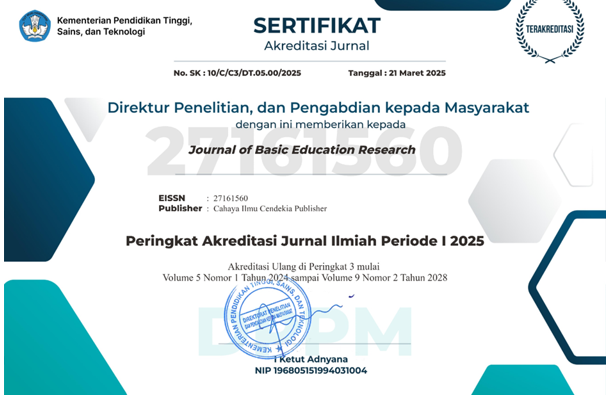Use of Crossword Media to Increase the Arabic Vocabulary of Higher Class in Elementary School
Abstract
Purpose of the study: This research aims to achieve the following objectives: Planning: Describe the planning process for utilizing Crossword Puzzle media to enhance the Arabic vocabulary of fifth-grade students at Madrasah Ibtidaiyah Nahdlatul Ulama’ (MINU) Maudlu’ul Ulum Pandean Malang. Implementation: Detail the implementation of Crossword Puzzle media to increase the Arabic vocabulary of class V students at MINU Maudlu’ul Ulum Pandean Malang. Evaluation: Provide insights into the evaluation of the effectiveness of Crossword Puzzle media in enhancing the Arabic vocabulary of class V students at MINU Maudlu’ul Ulum Pandean Malang.
Methodology: The research adopts a qualitative descriptive approach within the framework of classroom action research. The study comprises four stages: planning, implementation, observation, and reflection. Two cycles were conducted, involving a total of four meetings. Data collection methods include observation, interviews, and documentation. Triangulation is employed to ensure data validity. The research draws from a sample of class V students.
Main Findings: The research demonstrates that the use of crossword puzzles effectively enhances the Arabic vocabulary of class V students. Success indicators include: Positive Student Engagement: During the learning process, students exhibit happiness and enthusiasm. Improved Assessment Results: Student performance shows significant improvement compared to their initial results. Pre-test completion rate: 44.4% Cycle I: 77.7%, Cycle II: 83%
Novelty/Originality of this study: This study’s novelty lies in its potential as a reference tool for educators aiming to enhance the Arabic vocabulary of fifth-grade elementary school students using crossword puzzles.
References
E. Mitsea, A. Drigas, and P. Mantas, “Soft Skills & Metacognition as Inclusion Amplifiers in the 21 st Century,” International Journal of Online & Biomedical Engineering, vol. 17, no. 4, 2021, doi: 10.3991/ijoe.v17i04.20567.
D. Henriksen, C. Richardson, and K. Shack, “Mindfulness and creativity: Implications for thinking and learning,” Thinking skills and creativity, vol. 37, 100689, 2020, doi: 10.1016/j.tsc.2020.100689.
L. Li, A. D. I. Gow, and J. Zhou, “The role of positive emotions in education: A neuroscience perspective,” Mind, Brain, and Education, vol. 14, no. 3, pp. 220-234, 2020, doi: 10.1111/mbe.12244.
D. Kokotsaki, “Pupils’ views about their learning in writing: a qualitative study of a primary school in the North East of England,” International Journal of Primary, Elementary and Early Years Education, vol. 50, no, 2, 2022 doi: 10.1080/03004279.2020.1849342
J. Burgess, “Through a lens of affect: multiliteracies, English learners, and resistance,” Discourse: Studies in the Cultural Politics of Education, 41(5), 799-811, 2020, doi: 10.1080/01596306.2020.1769940
C. Szedlak, M. J. Smith, and B. Callary, “Developing a ‘letter to my younger self’to learn from the experiences of expert coaches,” Qualitative Research in Sport, Exercise and Health, vol. 13, no. 4, pp. 569-585, 2021, doi: 10.1080/2159676X.2020.1725609.
L. C. de Oliveira, L. Jones, and S. L. Smith, “A language-based approach to content instruction (LACI) for multilingual learners: Six Cs of scaffolding in first grade,” Journal of Language, Identity & Education, vol. 22, no. 5, pp. 429-444, 2023, doi: 10.1080/15348458.2021.1885409
M. Versteeg, G. Bressers, M. Wijnen-Meijer, B. W. Ommering, A. J. de Beaufort, and P. Steendijk, “What were you thinking? Medical students’ metacognition and perceptions of self-regulated learning,” Teaching and Learning in Medicine, vol. 33, no. 5, pp. 473-482, 2021, doi: 10.1080/10401334.2021.1889559
S. Williams, and L. McEwen, “Learning for resilience’as the climate changes: discussing flooding, adaptation and agency with children,” Environmental Education Research, vol. 27, no. 11, pp. 1638-1659, 2021, doi: 10.1080/13504622.2021.1927992.
K. Kopecka-Piech, “Neither anguish nor salvation: The necessity of media technology use by early adults living in Poland at the beginning of the COVID-19 pandemic,” Cogent Arts & Humanities, vol. 8, no. 1, pp. 2000124, 2021, doi: 10.1080/23311983.2021.2000124.
H. Yang, J. Kim, S. Kelly, and K. Merrill, “Learning in the Online Classroom: Exploring the Unique Influence of Social Presence Dimensions,” Communication Studies, vol. 73, no. 3, 2022, doi: 10.1080/10510974.2022.2074491.
A. Denes, R. McGloin, E. Hamlin, A. C. Speer, A. Coletti, and C. Guest, “Promoting peer connection in online courses: exploring the effect of media richness on presence and social connection,” Technology, Pedagogy and Education, vol. 32, no. 4, 2023, doi: 10.1080/1475939X.2023.2224347.
M. Koivula, S. M. Laaksonen, and M. Villi, “Practical, Not Radical: Examining Innovative Learning Culture in a Public Service Media Organization,” Journalism Studies, vol. 23, no. 9, 2022, doi: 10.1080/1461670X.2022.2065339.
D. Surwatay, and U. Raman, “Everyday negotiations in managing presence: young people and social media in India,” Information, Communication & Society, vol. 25, no. 4, 2022, doi: 10.1080/1369118X.2021.1988129.
N. M. Pham, and I. Jahnke, “Exploring indicators of teaching presence in online learning from older adult learners’ perspectives,” Technology, Pedagogy and Education, vol. 32, no. 4, 2023, doi: 10.1080/1475939X.2023.2233973.
S. N. Maskanah, J. Nugrawiyati, L. Qomariyah, W. Nafi'i, D. Dahlina, and F. M. A. Ibrahim, “Development Of Educational Crossword Puzzle Games In Arabic Vocabulary Learning For Madrasah Aliyah Students,” Jurnal Al-Maqayis, vol. 10, no. 1, pp. 22-35, 2023, doi: 10.18592/jams.v10i1.5999.
Z. Arkan, “Game Technique Applications in Teaching Arabic Words as a Foreign Language to Children,” Education Quarterly Reviews, vol. 5, no. 1, 2022, doi: 10.31014/aior.1993.05.01.447.
M. M. Al-Khataybeha, and A. A. M. H. Al-Ahdalb, “Enhancing Students’ Vocabulary through a Cross-Cultural Simulation Game,” International Journal of Innovation, Creativity and Change, vol. 14, no. 3, 2020, doi: 10.26858/eltww.v8i2.22631.
R. T. Putri, and R. N. Rambe, “Implementation of Crossword Puzzle Learning Media in Indonesian Language Learning at Islamic Elementary School,” Scaffolding: Jurnal Pendidikan Islam dan Multikulturalisme, vol. 5, no. 2, pp. 759-769, 2023, doi: 10.37680/scaffolding.v5i2.3345.
L. A. Jarrah, R. M. Ammari, A. S. A. H. Al-Talafha, and A. J. Khalifeh, “Student’s attitudes towards the use of games in teaching vocabulary for the second language learners,” Multicultural education, vol. 7, no. 12, pp. 387, 2021, doi: 10.5281/zenodo.5794577.
M. L. Lin, J. D. Lopez, A. Silva, K. Ali, V. Y. Brookshaw, M. G. Martinez, and D. C. Castillo, “Cognitive and socio-emotional benefits of puzzle working in older adults,” Activities, Adaptation & Aging, vol. 47, no. 3, pp. 348-363, 2023, doi: 10.1080/01924788.2022.2120761.
M. Farina, M. P. Lima, W. D. L. Machado, C. Moret-Tatay, R, M. F. Fernandes I. L. D. L. Argimon, and T. Q. Irigaray, “Components of an indirect cognitive reserve: a longitudinal assessment of community-dwelling older adults,” Aging, Neuropsychology, and Cognition, vol. 28, no. 6, pp. 907-920, 2021, doi: 10.1080/13825585.2020.1839377.
A. J. Dawes, and R. Wheeldon, “Why I became a chemistry teacher: identifying turning points in chemistry teacher narratives of their trajectories into teaching,” Research in Science & Technological Education, vol. 40, no. 4, pp. 454-477, 2022, doi: 10.1080/02635143.2020.1816951.
J. Moleong, and L. Lexy. Metodologi Penelitian Kualitatif: Edisi Revisi. Bandung; PT Remaja Rosdakarya, 2006.
W. Murni, and N. Ali, Penelitian Tindakan Kelas (Pendidikan Agama dan Umum dari teori Menuju Praktek disertai contoh hasil penelitian). Malang: UM Press, 2008.
S. Arikunto, Penelitian Tindakan Kelas. Jakarta: PT Bumi Aksara, 2008.
T. Leinonen, J. Brinck, H. Vartiainen, and N. Sawhney, “Augmented reality sandboxes: children’s play and storytelling with mirror worlds,” Digital Creativity, vol. 32, no. 1, pp. 38-55, 2021, doi: 10.1080/14626268.2020.1868535.
F. Gaini, and K. Sleire, “The wave cannot catch me: children, place and local knowledge in the Faroe Islands,” Children's Geographies, vol. 21, no. 1, pp. 40-51, 2023, doi: 10.1080/14733285.2022.2056433.
N. Fagerholm, C. M. Raymond, A. S. Olafsson, G. Brown, T. Rinne, K. Hasanzadeh, and M. Kyttä, “A methodological framework for analysis of participatory mapping data in research, planning, and management,” International Journal of Geographical Information Science, vol. 35, no. 9, pp. 1848-1875, 2021, doi: 10.1080/13658816.2020.1869747.
B. Pratolo, and R. Hafizhah, “The effectiveness of using crossword puzzle games to improve vocabulary mastery of the 7th grade students of SMP Muhammadiyah 2 Kalasan,” Teaching English as a Foreign Language Journal, vol. 1, no. 1, pp. 1-12, 2022, doi: 10.12928/tefl.v1i1.161.
S. Safitri, and S. Suryadi, “The Effect Of The Use Of Crossword Puzzle Media On Students' Vocabulary Mastery,” Journal of Educational Sciences, vol. 7, no. 1, pp. 85-94, 2023, doi: 10.31258/jes.7.1.p.85-94.
H. A. Klise, N. Pelenkahu, and T. Kumayas, “The use of crossword puzzle game to improve students’vocabulary mastery at smp negeri 2 tondano,” JoTELL: Journal of Teaching English, Linguistics, and Literature, vol. 2, no. 6, pp. 727-740, 2023, doi: 10.36582/jotell.v2i6.6437.
S. N. Maskanah, J. Nugrawiyati, L.Qomariyah, W. Nafi'i, D. Dahlina, and F. M. A. Ibrahim, “Development Of Educational Crossword Puzzle Games In Arabic Vocabulary Learning For Madrasah Aliyah Students,” Jurnal Al-Maqayis, vol. 10, no. 1, pp. 22-35, 2023.
W. Syafmen, and S. Indri, “Development of M-Learning Media Illustrated Crossword Puzzles to Increase Learning Motivation for Middle School Students,” Journal of Educational Science and Technology, vol. 9, no. 2, pp. 111-117, 2023, doi: .
M. Oktavia, C. Hiltrimartin, and D. Wati, “Improving Student Learning Outcomes Using Crossword Based Worksheet In Primary Schools”, J. Bs. Edu. R, vol. 4, no. 3, pp. 98-103, 2023, doi: 10.37251/jber.v4i3.725.
Copyright (c) 2024 Taqqiyyuddin Taqqiyyuddin, Somayeh Barzegar, Md. Saiful Islam

This work is licensed under a Creative Commons Attribution-NonCommercial 4.0 International License.
Authors who publish with this journal agree to the following terms:
- Authors retain copyright and acknowledge that the Journal of Basic Education Research is the first publisher licensed under a Creative Commons Attribution 4.0 International License.
- Authors are able to enter into separate, additional contractual arrangements for the non-exclusive distribution of the journal's published version of the work (e.g., post it to an institutional repository or publish it in a book), with an acknowledgment of its initial publication in this journal.
- Authors are permitted and encouraged to post their work online (e.g., in institutional repositories or on their website) prior to and during the submission process, as it can lead to productive exchanges and earlier and greater citation of published work.





.png)


.png)
.png)


















